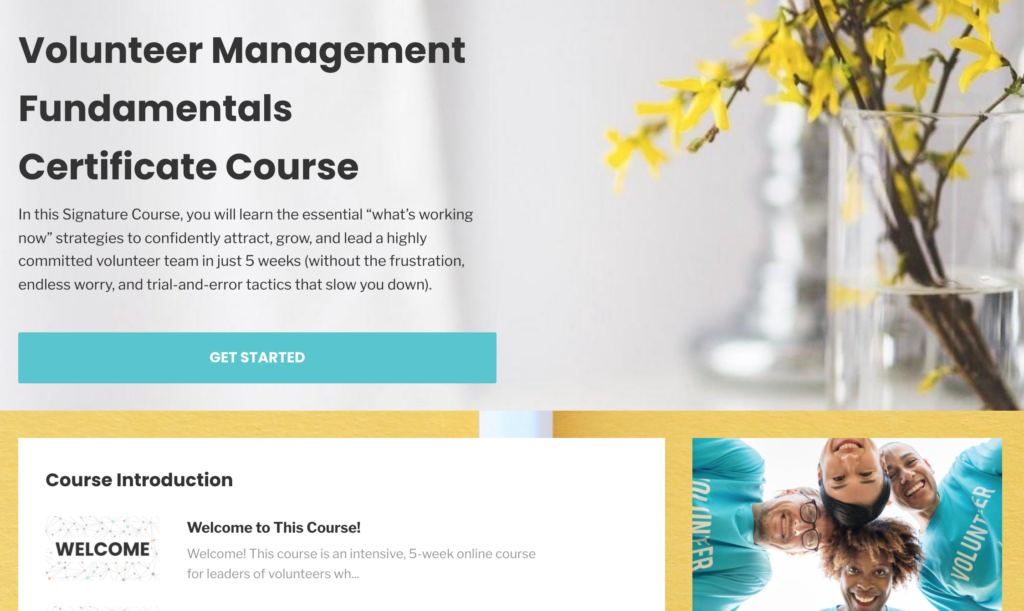
10 Must Have’s for a Well-Crafted Volunteer Job Description
A volunteer job description is an important communications and accountability tool. (Note: a better term is volunteer position description, or roles description, since no one gets paid.)
They map out expectations and indicate clear boundaries. They can also describe what’s possible, helping volunteers see that they are about to become part of something bigger than themselves.
Volunteer job descriptions probably aren’t the highlight of your volunteer induction process. Let’s face it, they tend to be a bit boring and dry, full of bureaucratic language and “thou shalt’s. But, when used correctly, nothing is better to inspire your new recruit! And nothing is better to find the right recruit, too.
What’s more, volunteer job descriptions are a helpful touchstone when volunteers aren’t quite meeting expectations. They are an essential tool when supervising volunteers and can help you spend more time being aspiration and less time nagging because you have done the up-front work needed to match the right volunteer with the right roles.
If a volunteer’s duties are clearly outlined in writing, both you and the volunteer have something to fall back on if there’s a misunderstanding and to gain clarity on where, exactly, support might be needed.
Finally, they also help reduce burnout in teams by making it clear what is inside the volunteer’s scope of work and what they do not have to worry about. A clear outline helps everyone set and maintain better boundaries.
At minimum, each volunteer job description should be explicit on how long the assignment will last, what will be produced, and what benefits there are both to the volunteer and to the organization.
You’ll likely, however, want to go above and beyond the minimum.
We’ve all hired volunteers only to realize they aren’t a good fit for the mission. Putting the right information in your volunteer job description will reduce that issue.
Read on for 10 things every volunteer job description should have and special sauce ways to attract the right volunteer for the right job.
10 Things Every Volunteer Job Description Should Have
Beyond just the nuts and bolts, read your description as if you were a potential volunteer who knows little-to-nothing about your organization. Would the job description entice you to commit your time and talents? Make sure you’ve got all the following sections and then jump to the bottom for tactic to find the perfect volunteer.
Volunteer tasks and expectations should be written in a way that ignites their inner superheroes, not in a way that deflates their sense of what’s possible.
Use the elements below to develop an informative and inspiring document that helps volunteers understand their role and commitment to the organization and paints a picture of the successes they will help achieve. Keep it brief and upbeat with no jargon
1. Job Title– The job title is more important than you might think. You want the volunteer to feel important, but not puffed up. And you want to accurately describe the role. Think of the job title as a way of distilling the entire job description down into a couple words.
2. Duties and Responsibilities– Include a bullet list of specific duties and requirements. You’ll want to use action verbs and present tense to give volunteers a concrete idea of their day-today. Also, make sure to describe only one duty or task at a time.
3. Time Requirements– Provide a realistic number of hours required per week/month, as well as the length of commitment with a start and end date.
4. Location– Include the primary location where the work will be performed.
5. Work Environment– Let the volunteer know any special tools that will be used or info about physical requirements of the job. This is also the place to include a dress code if you have one.
6. Skills & Qualifications– Here, you’ll want to list only the essentials. Make sure to address any misconceptions about what is required. If you have other desirable but not required qualifications, add another section for that.
7. Orientation & Training– You don’t have to go into depth here, but you’ll want to give the volunteer an idea of what they’re getting themselves into. Include the length of the orientation with a date and training dates if you have them.
8. Supervision & Support– Include who the volunteer’s direct supervisor will be and their contact information (email and phone).
9. Volunteer “Perks”– What are other things that might make volunteering with your organization more appealing than with others? is it free parking? Is it the ability to work remotely and with flexible roles? Is it extra in-service training. Don’t be shy. This is the place to brag on what you have to offer!
10. How to Apply … with Links– Link to application form and detail where and when to submit it, what to include, contact name and info for recruiter. Especially if you’re using job posting sites, one of the easiest ways to frustrate a potential volunteer (and probably send them packing) is to leave out a link to your website and a link to apply.
Atthough this looks like a lot of information, try not to overwhelm potential volunteers. Keep each section brief and to the point. Use bullets to help readers scan the page to find the information most helpful to them.
Make sure volunteers are a good fit for your nonprofit. Grab our Free [Cheat Sheet] The Top 10 Volunteer Interview Questions HERE >>

The Special Sauce: More Ways to Find the Right Person for the Job
Besides laying out what a position will look like, the main purpose of a volunteer job description is to find the right volunteer. In order to that you, you need to really think about your messaging, your target audience, and your volunteer’s potential motivations.
Check out some of the following. You can even turn them into a “Why Volunteer for Us” section at the bottom of a volunteer posting or your volunteer recruitment web page.
- The Impact of the Role – What have other volunteers achieved through this role? How does the work affect the community and people served by the program? Why does it matter in the scope of your mission? By including what volunteers in this role are already doing, you add momentum by showing what’s possible.
- Goals for the Role– This is a good place to play to the motivations of the kind of volunteer you’re searching for. A career-motivated volunteer may be more likely to apply if one of the goals is professional development. A social-oriented volunteer may be enticed by the chance to network. How can you align your goals with volunteer goals?
- The Benefits Volunteers Will Receive– What are the perks for volunteering? Is it making new friends, is it free lunch? These don’t have to be monetary. In fact, they are better if they are not. Do, however, include whether or not reimbursement for expenses is offered and what kind of training and professional development will be available.
- What People Are Saying– Social proof is a powerful tool and can support your volunteer job descriptions well. Include 3-5 quotes from volunteers, clients, and paid staff about the value of volunteers and the particular role in question. Why do volunteers enjoy this work? How would they recommend it to others? Why are staff grateful for their involvement? Why do clients appreciate the support volunteers offer? By including endorsements from volunteers, you reinforce that your organization is truly worthy of a deep commitment.
- Team Values– When you include what values your team exhibits, you allow the right person to find your position. A short bullet list is all it takes to let the wrong person for the job move on to something else.
- Your Agency’s Philosophy of Volunteer Involvement– Your rationale helps prospective volunteer understand how volunteerism plays into the larger picture at your organization. Why are volunteers included as part of your agency’s human resources strategy beyond simply and extra pair of hands or to save money? What unique value to they bring to the table?
Now it’s your turn.
Take an honest look at your volunteer job descriptions.
Would they entice you to commit your time and talents? Would they inspire you to get started right away?
If not, think about refreshing them with some new information that is relevant and mission driven.
Strengthen Your Nonprofit’s Volunteer Program in 2022
Are you ready to build, grow, and scale your volunteer efforts in 2022? If so, then our signature online course is the perfect fit for you.
We will be opening enrollment in early 2022. So, now is the time to join our waitlist so that you get our early alerts when the doors are about to open.
Join the wait List for Our Next Session – Volunteer Management Fundamentals Certificate
Join us for the most comprehensive program in the field for leading a high-impact volunteer engagement strategy that works.
This online course is the only implementation program of its kind that not only shows you exactly how to attract qualified volunteers – but how to make your org the place they want to return to again and again.
Over 8 weeks of instruction, combined with weekly live Q&A coaching calls, you will learn everything you need to implement or make improvements to your volunteer programming. As a student, you’ll also be invited to our live Q&A coaching calls and have lifetime access to the course.
Isn’t it time you stopped hunting and pecking for answers and spinning your wheels on a half-baked volunteer strategy? Now is the time to get your systems in place with our help.
The Volunteer Management Fundamentals Certificate is the complete package to help you get there!









Wonderful ideas at just the right time. I’m going to use this during my summer downtime to jazz up our volunteer descriptions.
Georgann: Glad you found the ideas helpful, and what a great way to spend your slow season!